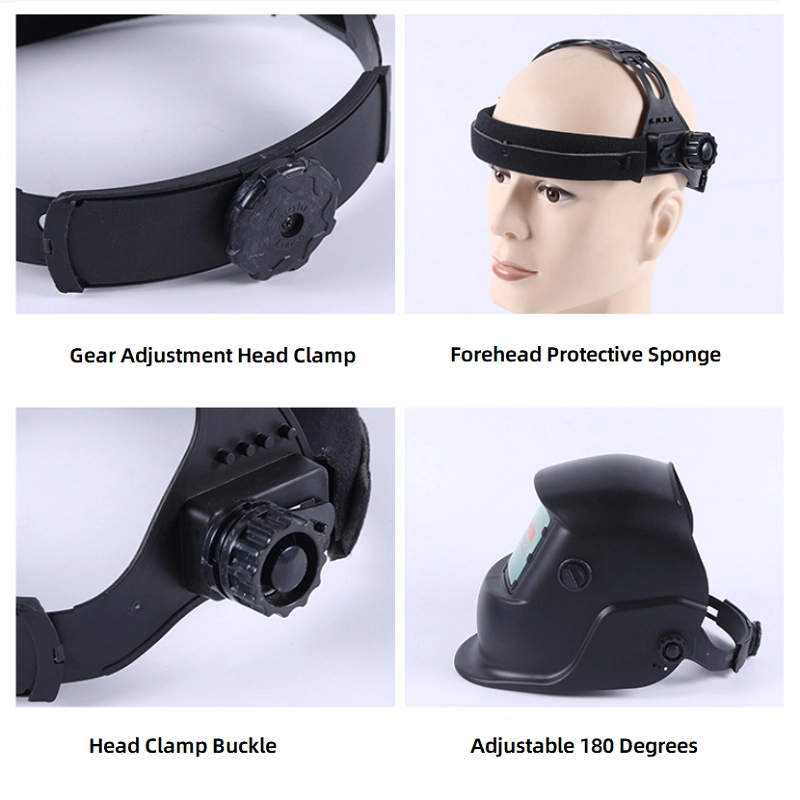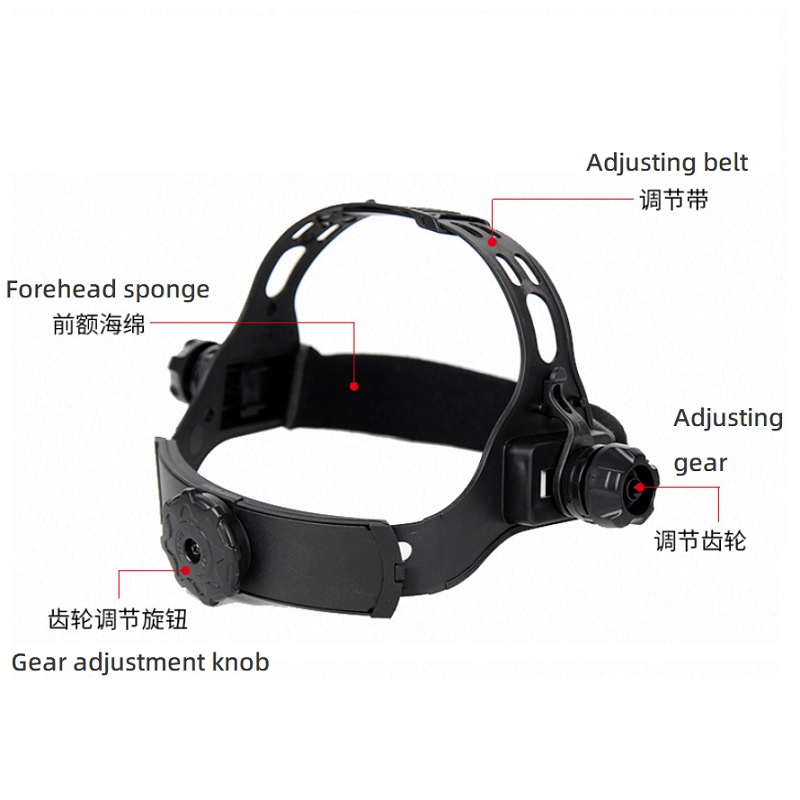Selecting the Right Welding Helmet: Your Ultimate Guide to Safety and Comfort
Are you a seasoned welder or just starting your journey into the exciting world of metal fabrication? Choosing the right welding helmet is crucial for your safety, comfort, and the quality of your work. This comprehensive guide will walk you through everything you need to know about selecting the right welding helmet, from understanding different lens types to considering essential features and safety standards. Get ready to make an informed decision that will enhance your welding experience!
Why is a Quality Welding Helmet So Important for Every Welder?
For any welder, whether you're working on intricate projects or heavy-duty industrial tasks, a quality welding helmet isn't just an accessory; it's an indispensable piece of personal protective equipment. Imagine trying to weld without proper eye and face protection – the intense light and harmful UV/IR radiation from the weld arc can cause severe, irreversible eye damage in mere seconds. This isn't just about discomfort; it's about protecting your long-term vision and ensuring you can continue your craft safely. A good welding helmet shields your eyes and face from these dangers, as well as from sparks, spatter, and debris that are an inherent part of welding operations.
Beyond immediate safety, a high-quality welding helmet significantly impacts your efficiency and overall welding experience. Think about it: if your vision is constantly strained or you're struggling with a poorly fitting helmet, your focus will be divided, leading to mistakes and fatigue. A well-designed welding helmet allows you to see your workpiece clearly, helps you maintain a steady hand, and contributes to cleaner, more precise welds. It’s an investment in both your personal well-being and your professional output.
Fixed Shade vs. Auto-Darkening: Which Lens Type is Right for You?
When it comes to the core functionality of a welding helmet, the primary decision revolves around the lens type: fixed shade or auto-darkening. Each has its own set of advantages and is suited for different welding experiences and preferences.
A fixed shade lens, as the name suggests, maintains a constant dark shade. Traditionally, welders would "nod" their welding hood down just before striking an arc. The main benefit of a fixed shade helmet is its simplicity and often lower cost. They are durable and reliable, making them a solid choice for those who perform consistent, predictable welding tasks, such as dedicated stick welding or MIG welding at a constant amperage. However, the downside is that you can't see your workpiece clearly before the arc is struck, which can lead to positioning errors and requires flipping the helmet up and down, interrupting your workflow and increasing the risk of exposure.

On the other hand, an auto-darkening welding helmet features a special lens that automatically darkens to a pre-selected shade level when it detects the weld arc. This is a game-changer for many welders because it allows you to keep the welding helmet in place before, during, and after welding, offering continuous protection and a clear view of your work area. The convenience and enhanced safety of not having to constantly "nod" your head or flip the helmet are invaluable, especially for intricate work or for welders who frequently switch between different welding tasks. Modern welding helmets with auto-darkening technology have become the standard for many professionals due to their versatility and user-friendliness.
Understanding Auto-Darkening Helmets: What Features Should You Look For?
If you decide to go with an auto-darkening helmet, you're opening up a world of features designed to make your welding life easier and safer. But with so many options, how do you choose a welding helmet that truly fits your needs?
One of the first things to consider is the shade range. Most auto-darkening lenses offer a variable shade, typically ranging from a light shade (like DIN 3 or 4) for grinding or clear viewing, to darker shades (DIN 9 to 13) for welding. Some advanced models might even go up to DIN 14 or 15 for extremely high amperage welding processes. Having a wide shade range ensures versatility for different welding processes and applications. Look for easy-to-use external controls to adjust the shade, which is particularly useful if you frequently switch between different welding tasks without having to remove your welding hood.
Another critical feature is the number of arc sensors. Most auto-darkening welding helmets come equipped with at least two sensors, but four sensors are generally preferred, especially for outdoor work or when your line of sight to the arc might be partially obstructed. More sensors mean a more reliable and consistent darkening of the lens, reducing the risk of arc flash. Also, pay attention to the switching speed – this is how quickly the lens transitions from light to dark once the arc is struck. A faster switching speed (measured in milliseconds, e.g., 1/25,000th of a second) reduces eye fatigue and protects your eyes from sudden flashes, contributing to a better overall welding experience.
Decoding Welding Helmet Shades: How to Use a Welding Helmet Shade Chart Effectively?
Understanding welding helmet shades is absolutely fundamental to your safety. The shade level of your welding lens determines how much light from the weld arc reaches your eyes. Too light, and you risk severe eye damage; too dark, and you won't be able to see your work. So, how do you choose the right welding helmet shade?
The key is to consult a welding helmet shade chart. These charts, often provided by manufacturers or found through organizations like the Occupational Safety and Health Administration (OSHA), correlate the type of welding process, the amperage being used, and the appropriate shade level. For example, a MIG welding operation at 100 amps might require a shade 10, while stick welding at 250 amps could necessitate a shade 12 or 13. It's not a one-size-fits-all situation; different welding processes generate varying intensities of light and UV/IR radiation.
When using an auto-darkening helmet, you can adjust the shade settings to match the recommendations on the chart for your specific type of welding process. For fixed shade helmets, you'll need to ensure you have the correct fixed shade lens installed for the task at hand. Always err on the side of caution; if you're unsure, it's generally safer to use a slightly darker shade. The wrong shade can cause eye strain, discomfort, and potentially serious injury. Regularly checking the chart and understanding the intensity of the welding arc you're producing is vital for safe and effective welding sessions.

Viewing Area and Optical Clarity: Do Bigger and Clearer Mean Better?
When you're staring at your workpiece through a small window for extended periods, the size of your viewing area and the optical clarity of your lens become incredibly important. So, when picking the right helmet, do bigger and clearer really mean better? In most cases, yes!
A larger viewing area provides a broader field of vision, which can significantly improve your precision and reduce neck strain. Instead of constantly repositioning your head to see different parts of your weld puddle or the surrounding area, a larger viewing area allows for a more natural and comfortable head position. This is especially beneficial for complex welds, long welding sessions, or when you need to keep an eye on your torch angle and material flow. Standard welding helmets might offer a relatively small viewing area, while more advanced auto-darkening welding helmets often boast a generous, larger viewing area, making detailed work much easier.
Optical clarity refers to how clear and undistorted your view through the lens is. Lenses are typically rated on a scale of 1 to 3 for optical quality in four categories: optical class, diffusion of light, variations in luminous transmittance, and angle dependence. A rating of 1/1/1/1 is considered the best optical class, indicating minimal distortion, consistent shade across the lens, and good visibility from different angles. High optical clarity reduces eye fatigue, allowing you to see colors more accurately and distinguish details in the weld puddle with greater ease. This leads to better quality welds and a more comfortable overall welding experience. Investing in a helmet with superior optical clarity is a wise decision for any serious welder.
Comfort and Fit: Can a Welding Helmet Really Be Comfortable During Long Welding Sessions?
Absolutely! The comfort and fit of your welding helmet are paramount, especially during long welding sessions. An uncomfortable helmet can be a major distraction, leading to fatigue, neck pain, and ultimately, a decrease in productivity and weld quality. You're wearing this piece of equipment for hours on end, so it needs to feel right.
Many modern welding helmets are designed with ergonomic headgear that can be adjusted in multiple ways to conform to different head shapes and sizes. Look for features like padded headbands, multiple adjustment points for height and tension, and a balanced design that distributes the helmet's weight evenly. A lightweight helmet is also a huge plus, as even a few extra ounces can make a big difference over an eight-hour shift. Lighter helmets help reduce neck strain, allowing you to focus on your work rather than on an aching neck.
The material of the helmet itself also contributes to comfort. Some helmets are made from lighter, more flexible plastics, while others incorporate robust but heavier materials for extreme durability. Ventilation can also be a factor, especially in hot environments, to prevent fogging and improve airflow. Before committing to a purchase, it's always a good idea to try on different models, if possible, to see how they feel and adjust. A comfortable, well-fitting helmet will significantly enhance your overall welding experience.

Power Sources and Sensors: What Powers Your Protection?
The advanced functionality of auto-darkening welding helmets relies on sophisticated power sources and sensors. Understanding these components will help you choose the right helmet that offers reliable and consistent protection.
Most auto-darkening lenses are powered by a combination of solar cells and replaceable batteries. The solar cells constantly recharge internal batteries (or assist in powering the lens directly), extending the life of the replaceable batteries. This dual power source ensures that your lens is always ready when you are. When considering an auto-darkening welding helmet, check the battery type and ease of replacement. Some helmets use standard AAA batteries, while others might use specialized coin cells. Easy access to the battery compartment is a convenience you'll appreciate when it's time for a change.
As mentioned earlier, the arc sensors are crucial for detecting the flash of the weld arc and triggering the lens to darken. While two sensors are the minimum, four sensors provide superior detection, especially in situations where the arc might be partially obscured or when welding out of position. These sensors are strategically placed around the lens to ensure a consistent and rapid response, no matter the angle of the arc. The sensitivity of these sensors is often adjustable, allowing the welder to fine-tune the helmet's response to different lighting conditions and welding processes, preventing unwanted darkening or flashing when welding near other active arcs.
Meeting Safety Standards: What Certifications Should Your Welding Helmet Have?
Safety should always be your top priority, and when it comes to welding helmets, this means ensuring your chosen product meets the necessary safety standards. These certifications aren't just bureaucratic hurdles; they are proof that the welding helmet has been rigorously tested and provides adequate protection against the hazards of welding.
In the USA, look for helmets that comply with ANSI Z87.1 standards. This standard covers requirements for personal eye and face protection devices, including impact resistance, optical quality, and UV/IR protection. For products exported to Europe, the CE marking (Conformité Européenne) is essential, indicating compliance with European health, safety, and environmental protection standards, specifically EN 379 for welding filters. As a factory specializing in protective gloves and apparel, we ensure all our products, including welding helmets, meet relevant international safety standards to provide the utmost protection for end-users.
Always check the product specifications and the helmet itself for these markings. A reputable supplier will clearly display their certifications, offering you peace of mind that you're investing in a product that genuinely protects. Don't compromise on safety; a certified helmet is a non-negotiable requirement for any welder. When choosing a welding helmet, make sure the helmet you choose meets these critical safety standards.
Specialized Welding Helmets: Are There Helmets for Every Type of Welding Process?
Given the diverse range of welding processes, it's natural to wonder if there are specialized helmets tailored for specific applications. The answer is a resounding yes! While many general-purpose auto-darkening welding helmets offer versatility across different types of welding, some specific processes or environments benefit greatly from specialized features.
For instance, TIG welding, which involves lower amperages and produces a less intense arc, often requires auto-darkening lenses with enhanced sensitivity and a lower minimum shade setting (e.g., DIN 5 or 6). This allows the welder to see the delicate TIG arc more clearly without straining their eyes. Some helmets are specifically designed with TIG welders in mind, offering superior clarity and responsiveness at low amperages. Our Dongtie TIG Welding Protective Mask is an excellent example, engineered for precision and comfort in TIG welding.
For applications involving overhead welding or extremely high heat, a lightweight helmet with good heat reflection properties and extended neck protection might be preferred. Welding helmets equipped with respiratory systems (PAPR - Powered Air-Purifying Respirators) are also available for environments with hazardous fumes, offering integrated breathing protection. Similarly, for precision work where visibility of the grinding process is crucial, some modern welding helmets have a "grind mode" that locks the lens in a light shade (usually DIN 3 or 4), allowing the welder to switch between welding and grinding without removing the helmet. This versatility ensures that regardless of the type of welding, there's a helmet designed to meet the specific demands of the task.
Making Your Choice: What Should You Consider When Buying a Welding Helmet for the First Time?
Buying your first welding helmet can feel a bit overwhelming with all the options available. As a procurement officer like Mark Thompson, you'd want to consider a blend of quality, cost-effectiveness, and user-centric features. Here's a breakdown of what to keep in mind:
First, consider your primary use. What type of welding process will you be doing most often? If you're a hobbyist doing occasional MIG welding, a basic auto-darkening helmet with reliable sensors might suffice. If you're entering a professional setting with diverse arc welding tasks, investing in a variable shade auto-darkening helmet with a wider shade range and good optical clarity is a smarter move.
Secondly, don't overlook comfort. Even the best welding helmet won't be used effectively if it's uncomfortable. Try on different models to assess the fit of the headgear and the weight of the helmet. Look for adjustable settings and padding. A comfortable fit will make your long welding sessions much more bearable and help you maintain focus.
Lastly, always prioritize safety certifications (ANSI Z87.1, CE EN379). These are non-negotiable. While price is always a factor, especially for distributors like Mark, a quality welding helmet is an investment in safety and efficiency that pays dividends in the long run. Good communication with your supplier, like us at DTlabor, can also address concerns about quality inspection, logistics, and certifications. We pride ourselves on offering durable materials and compliance with relevant safety standards for all our labour protection products.
Key Takeaways for Choosing Your Welding Helmet:
- Prioritize Safety: Always ensure your welding helmet meets relevant safety standards like ANSI Z87.1 or CE EN379.
- Auto-Darkening for Versatility: For most welders, an auto-darkening helmet offers superior convenience and continuous protection compared to a fixed shade lens.
- Understand Shade Levels: Use a welding helmet shade chart to select the correct shade for your specific welding process and amperage to prevent eye strain and injury.
- Optimize Your View: A larger viewing area and high optical clarity (1/1/1/1 rating) will reduce eye fatigue and improve weld precision.
- Comfort is King: Choose a lightweight helmet with adjustable, ergonomic headgear for comfort during long welding sessions.
- Check Power & Sensors: Look for helmets with reliable solar/battery power and at least four arc sensors for consistent darkening.
- Consider Your Needs: Match helmet features to your specific welding tasks and experience level, whether it's TIG welding, MIG welding, or general fabrication.






